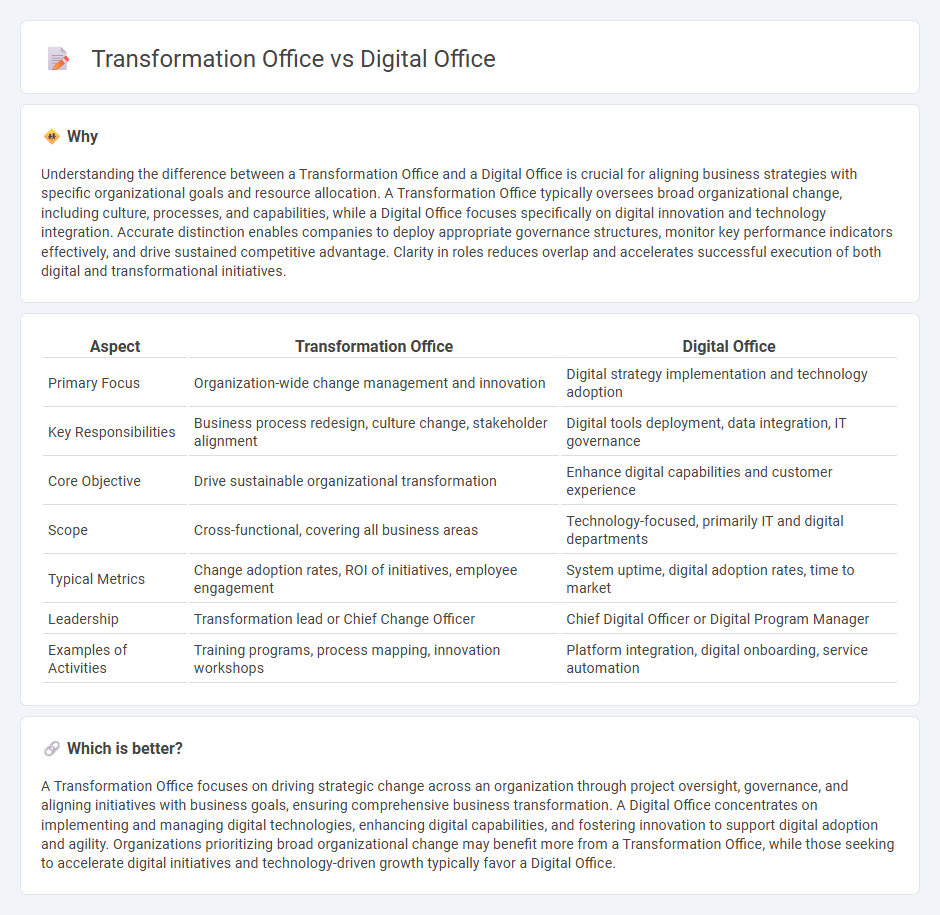
Transformation offices focus on orchestrating strategic change initiatives across organizational functions to enhance overall business performance. Digital offices specialize in implementing and managing technology-driven solutions that enable digital innovation and operational efficiency. Explore the key differences in scope, objectives, and impact between Transformation and Digital Offices to optimize your organization's growth strategy.
Why it is important
Understanding the difference between a Transformation Office and a Digital Office is crucial for aligning business strategies with specific organizational goals and resource allocation. A Transformation Office typically oversees broad organizational change, including culture, processes, and capabilities, while a Digital Office focuses specifically on digital innovation and technology integration. Accurate distinction enables companies to deploy appropriate governance structures, monitor key performance indicators effectively, and drive sustained competitive advantage. Clarity in roles reduces overlap and accelerates successful execution of both digital and transformational initiatives.
Comparison Table
| Aspect | Transformation Office | Digital Office |
|---|---|---|
| Primary Focus | Organization-wide change management and innovation | Digital strategy implementation and technology adoption |
| Key Responsibilities | Business process redesign, culture change, stakeholder alignment | Digital tools deployment, data integration, IT governance |
| Core Objective | Drive sustainable organizational transformation | Enhance digital capabilities and customer experience |
| Scope | Cross-functional, covering all business areas | Technology-focused, primarily IT and digital departments |
| Typical Metrics | Change adoption rates, ROI of initiatives, employee engagement | System uptime, digital adoption rates, time to market |
| Leadership | Transformation lead or Chief Change Officer | Chief Digital Officer or Digital Program Manager |
| Examples of Activities | Training programs, process mapping, innovation workshops | Platform integration, digital onboarding, service automation |
Which is better?
A Transformation Office focuses on driving strategic change across an organization through project oversight, governance, and aligning initiatives with business goals, ensuring comprehensive business transformation. A Digital Office concentrates on implementing and managing digital technologies, enhancing digital capabilities, and fostering innovation to support digital adoption and agility. Organizations prioritizing broad organizational change may benefit more from a Transformation Office, while those seeking to accelerate digital initiatives and technology-driven growth typically favor a Digital Office.
Connection
The Transformation Office and Digital Office collaborate to drive organizational change by integrating digital strategies with overall business transformation initiatives. The Transformation Office focuses on aligning change management, governance, and performance metrics, while the Digital Office spearheads technology adoption, data analytics, and digital innovation. Their interconnected roles ensure seamless execution of digital transformation projects that enhance operational efficiency and competitive advantage.
Key Terms
Digital Strategy
A Digital Office centralizes the management of digital initiatives, focusing on the implementation of technology solutions to enhance operational efficiency and customer experience. A Transformation Office drives broader organizational change, integrating digital strategy with business model innovation, culture shift, and process reengineering to achieve long-term agility and competitive advantage. Explore how aligning your digital strategy with the right office can accelerate sustainable business growth.
Change Management
A Digital Office primarily drives the integration of digital technologies across business processes, enhancing efficiency and user experience, while a Transformation Office oversees broader organizational change, including strategic shifts and cultural adaptation with a strong emphasis on Change Management frameworks like ADKAR or Kotter's Model. Change Management within a Transformation Office ensures stakeholder alignment, minimizes resistance, and accelerates adoption of new initiatives, whereas the Digital Office focuses more on technology-enabled change and agile implementation. Explore further to understand how each office uniquely propels organizational growth through structured change management.
Governance Model
Digital Office emphasizes operational efficiency by implementing standardized processes, tools, and governance frameworks to support digital initiatives across the organization. In contrast, the Transformation Office drives strategic change, aligning governance models with broader business objectives and managing complex transformation programs that require cross-functional collaboration. Explore the distinct governance approaches and strategic impacts of each to optimize your organization's digital transformation journey.
Source and External Links
Exploring the Digital Office: Tomorrow's Workplace - A digital office is a virtual workspace using technology and virtual tools to facilitate communication, collaboration, and productivity, enabling remote teams to work effectively regardless of location.
What Is a Digital Office & How Does It Work? - It is a cloud-based setup combining SaaS/PaaS tools tailored by industry to support remote work and collaboration using apps like Slack, Zoom, Google Suite, Asana, and others.
Amazon Digital Office - AWS Marketplace - Amazon Digital Office provides automated digital workflows with eSignatures and integrations, enabling paperless remote work and secure business processes.
 dowidth.com
dowidth.com